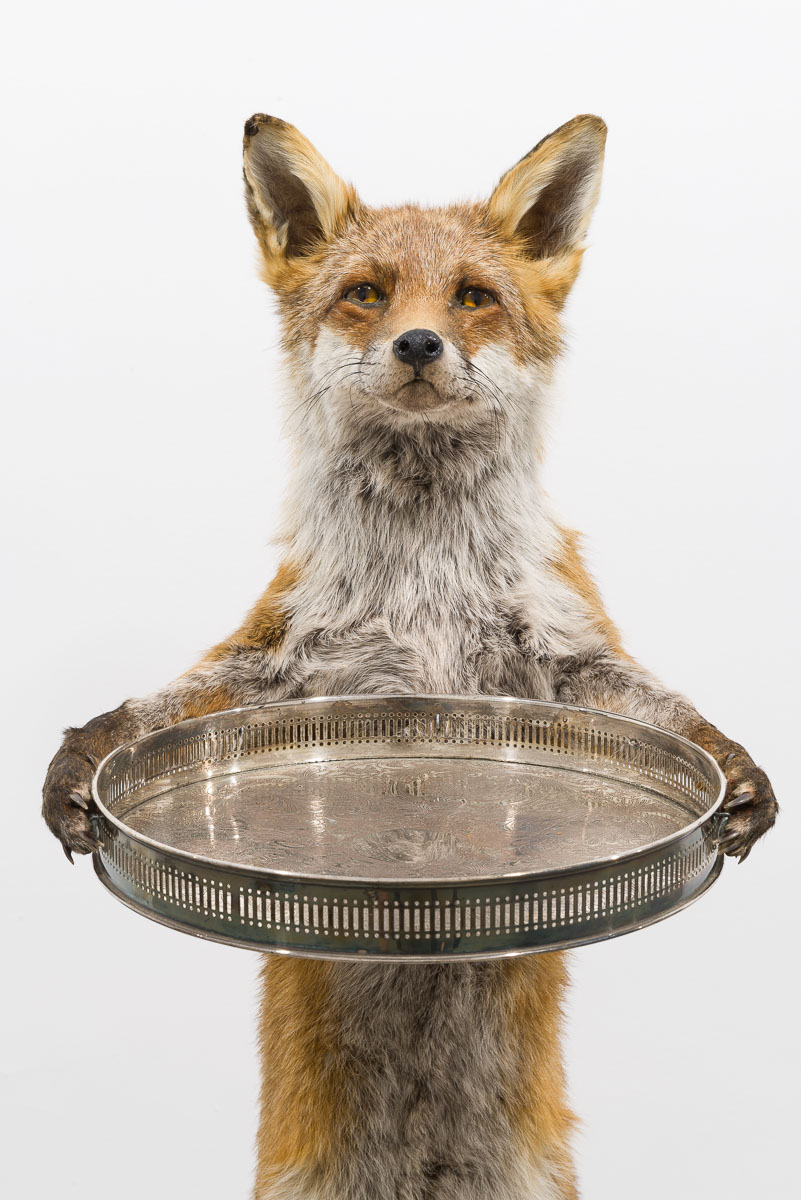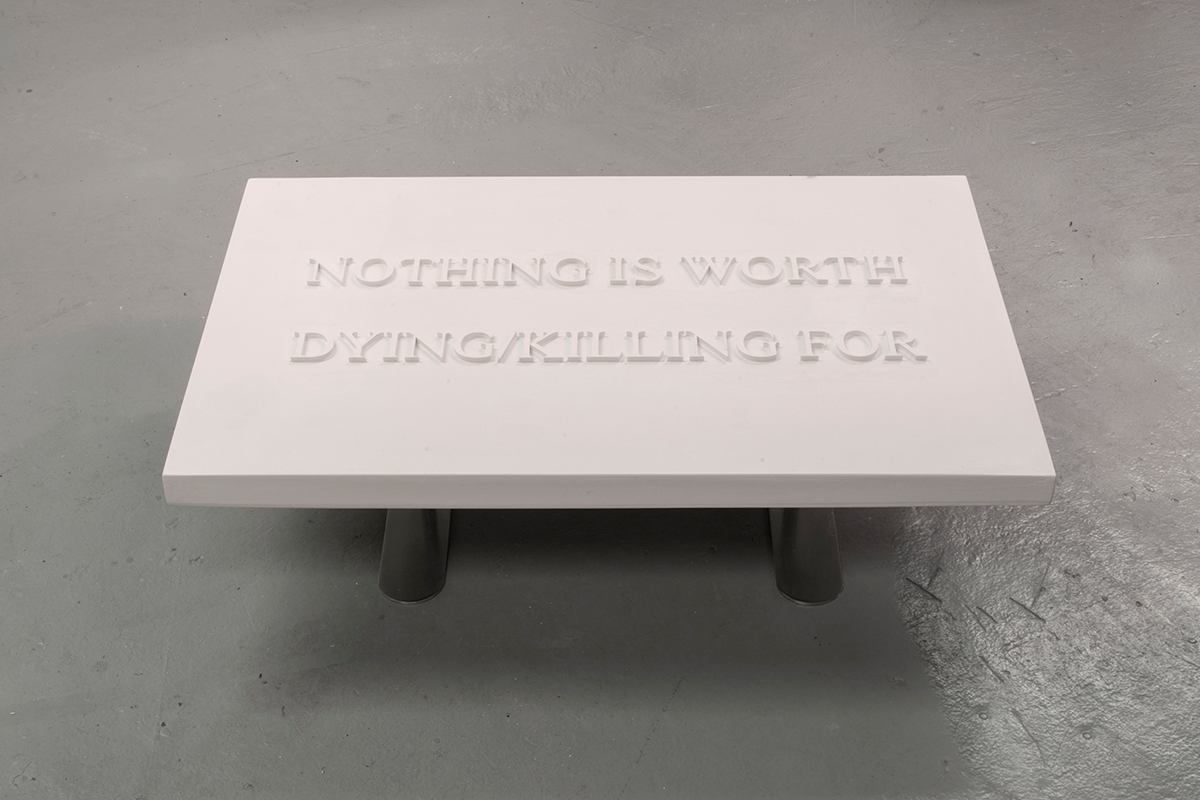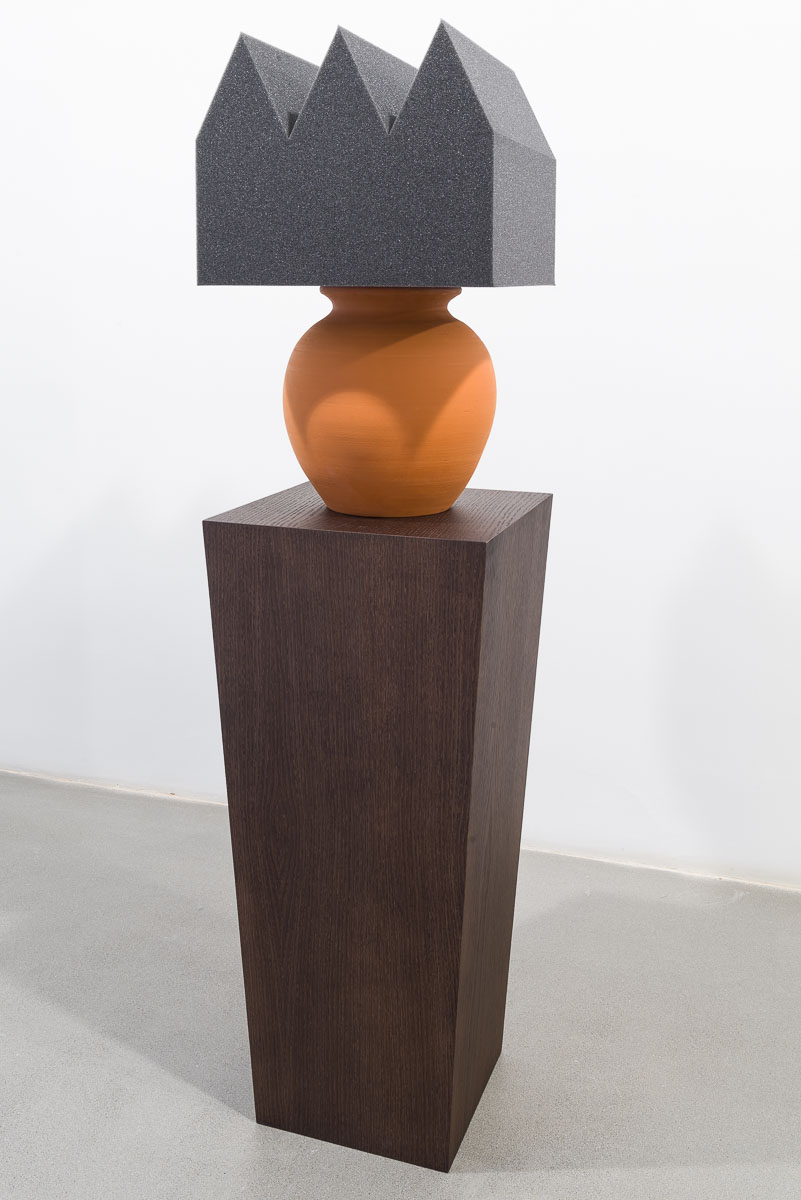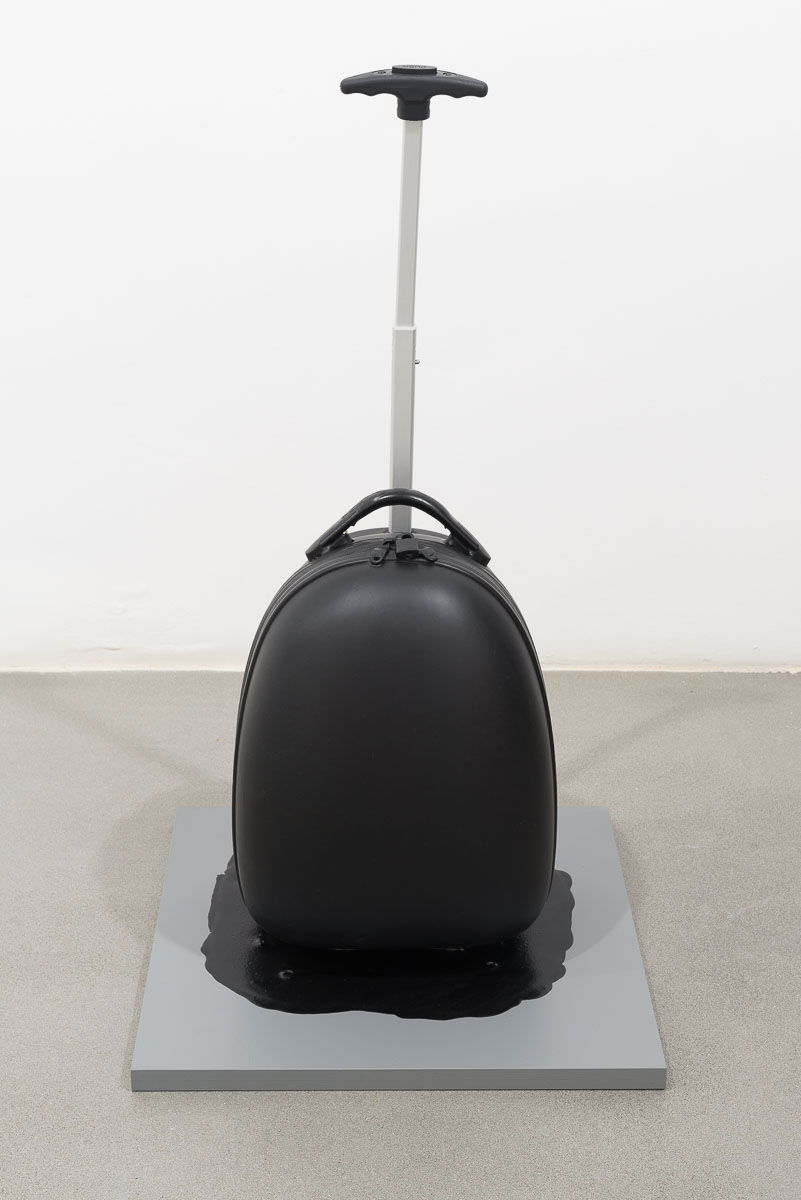"In No Particular Hurry"
Babak Golkar
SABRINA AMRANI
Calle Madera 23. 28004 Madrid, Spain
T: +34 627 539 884 e-mail:
15th September > 29 October, 2016
 The Fox, The Nut and The Banker’s Hand , 2016-2116. Stuffed fox, silver tray and concealed object. 104x36 x45 cm |
 Nothing is worth dying/killing for , 2016-2116. Hydrostone, metal support and concealed object. 50x35x22 cm. |
 Long Live Max Yasgur , 2015. Acoustic foam, plinth, terracotta and concealed object, 148x38x38 cm. |
 Inherited revolution , 2016-2116. Kids carry-on luggage, PlastiDip and concealed object. 90x47x50 cm. |
Sabrina Amrani is pleased to present In No Particular Hurry, the first solo exhibition in Spain by Canadian artist Babak Golkar. This exhibition features a series of new sculptural assemblages titled Time Capsules (2016-2116).
Golkar’s latest body of work - composed of taxidermy, ceramics, 3D printed ABS, among other materials - questions the notions of value creation and the role of the artist in governing these systems. Through the artist’s use of time as a key connecting material, all works unpack dominant geo-political issues that have emerged through his close engagement with each object and their associated histories. For the project Golkar bracketed roughly 200 years in researching materials and their processes; experiences and conditions from the last hundred years and how they have or will continue to affect us.
Varying in scale and form, each work in Time Capsules contains a concealed artwork unknown to anyone but the artist. It is ill-advised to unveil their interiors until the suggested time has passed, inevitably outliving the artist and those who initially acquire the work. If any capsule opens prior to the passing of one hundred years, the artworks become void and their economic value drops to zero by way of a written agreement between Golkar and the collector. It is only at this threshold that the objects fully manifest themselves, becoming anew in 2116.
Golkar describes Time Capsules as a way to further consider the practice of photography and its limitations. He states: “Photography is a form of preserving time - denoting a certain subject but also what it is not there. There is a frame that plays with both a concealment and exposure. I am often unresolved with photography and perhaps the capsules make for a more complicated simultaneity of pseudo-presence and tokens of absence. The difference here lies in the potency of what is entrapped within the capsules. In Time Capsules art transpires in the space between the container and the contained.”
Elevated from the gallery floor by a stainless steel stand appears a thick plaster slab that reads NOTHING IS WORTH DYING/KILLING FOR , an epitaph also describing the title of the work. Formed using material associated with Death Mask casting, Golkar has composed what he describes as a short poem to articulate a current state of love; setting rationality into emotionality and re-contextualizing these particular terms of violence. This discreet and ambiguous marker conjures feelings not of comfort, but of brief respite amongst larger phenomenological forces.
Towering seven feet above stands a fibreglass replica of a statue origi- nally found in an appendix to the Parthenon. Titled The Weight of the World , this Grecian-inspired female contrapposto still holds the moul- ding that once connected it to a larger structure - now an abstracted mass. Used not as architectural support but for pure adornment, “it’s an incredibly insensitive afterthought and maybe one of the first represen- tations that describes the weight of the world on women.”
Through these considerations of valuation one returns to a historical perspective of the avant-garde not only through associations made between these works and the readymade, but also in thinking of art and agency. In Marcel Duchamp’s 1957 text The Creative Act , he outlines a power within the viewer to define the weight of art, on an aesthetic scale, through their subjective engagement. He outlines that an object’s participation with the public delineates its social value, perhaps initially outside an economic system. In the case of Golkar’s Time Cap- sules , the objects are made with an added system of value regulation in mind. By doing so, the artist gains a power to uphold specific formal and conceptual intentions in the face of an increasingly nebulous audience and market.
In 1969, organizers of the Woodstock Music and Art Festival began looking for a secondary site to host their event after being banned from occupying venues in Woodstock, New York. Ultimately the event took place on a 600-acre dairy farm in Bethnal, New York owned by Max Yasgur, forever branding both the family and land. Long Live Max Yasgur is composed solely of objects associated with the context of Woods- tock. Atop the three stacked components is a sculpted acoustic foam object that references the Age of Aquarius, fashioned as a graphic form with peaks and ridges. Below, a large ceramic pot is wedged into the base of this crowned top and is historically tied to the water buckets Yasgur used to keep the crowds hydrated during the festival. Suppor- ting the entire sculpture is a MDF plinth disguised using veneer from a much more cherished wood found in the forests of the festival. Each element has been combed from the past ecological and social environ- ments of this utopian event, forming a work that carries with it an equally generous yet deceptive philosophy between materials and conceal- ment.
Inherited Revolution consists of a small hardshell suitcase coated in a thick black rubber, emphasizing its elegant and subtle arched form. Often designed as the essence of speed, weightlessness and durabili - ty, travel objects take on an undoubtedly futurist sensibility; synony- mous with ideologies behind brands like Porsche Design or Tesla. Out of all eight works, Inherited Revolution appears as one of most sealed or inaccessible due to its limited material use and homogeneous form. Built into its title, this striking bodily sculpture gestures to cycles of the generational, modes of contemporary agency and the symbolic poten- cy behind this particular vessel.
Just as Golkar’s process of renewal speaks to destructive and immate- rial gestures within key historical works of art, marketing terms are equally relevant here. One could say that a single acquisition produces two artworks (quite literally two for the price of one). This prompts an additional nod to the 20th century Avant-Garde in thinking of art as a larger social tool for challenging moral and economic ideologies through works that demonstrate both playfulness and critique. This proposal made by Golkar underlines how the use of time assists to build more complicated relationships with art and objects, affording us to fundamentally question what influences us to collect, conceal or attri- bute value.
In No Particular Hurry is part of Apertura Madrid Gallery Weekend.
A selection of works from the Time Capsules (2016-2116) series will be showcased by Sabrina Amrani in a solo presentation at Artissima 2016, Turin.
Golkar’s latest body of work - composed of taxidermy, ceramics, 3D printed ABS, among other materials - questions the notions of value creation and the role of the artist in governing these systems. Through the artist’s use of time as a key connecting material, all works unpack dominant geo-political issues that have emerged through his close engagement with each object and their associated histories. For the project Golkar bracketed roughly 200 years in researching materials and their processes; experiences and conditions from the last hundred years and how they have or will continue to affect us.
Varying in scale and form, each work in Time Capsules contains a concealed artwork unknown to anyone but the artist. It is ill-advised to unveil their interiors until the suggested time has passed, inevitably outliving the artist and those who initially acquire the work. If any capsule opens prior to the passing of one hundred years, the artworks become void and their economic value drops to zero by way of a written agreement between Golkar and the collector. It is only at this threshold that the objects fully manifest themselves, becoming anew in 2116.
Golkar describes Time Capsules as a way to further consider the practice of photography and its limitations. He states: “Photography is a form of preserving time - denoting a certain subject but also what it is not there. There is a frame that plays with both a concealment and exposure. I am often unresolved with photography and perhaps the capsules make for a more complicated simultaneity of pseudo-presence and tokens of absence. The difference here lies in the potency of what is entrapped within the capsules. In Time Capsules art transpires in the space between the container and the contained.”
Elevated from the gallery floor by a stainless steel stand appears a thick plaster slab that reads NOTHING IS WORTH DYING/KILLING FOR , an epitaph also describing the title of the work. Formed using material associated with Death Mask casting, Golkar has composed what he describes as a short poem to articulate a current state of love; setting rationality into emotionality and re-contextualizing these particular terms of violence. This discreet and ambiguous marker conjures feelings not of comfort, but of brief respite amongst larger phenomenological forces.
Towering seven feet above stands a fibreglass replica of a statue origi- nally found in an appendix to the Parthenon. Titled The Weight of the World , this Grecian-inspired female contrapposto still holds the moul- ding that once connected it to a larger structure - now an abstracted mass. Used not as architectural support but for pure adornment, “it’s an incredibly insensitive afterthought and maybe one of the first represen- tations that describes the weight of the world on women.”
Through these considerations of valuation one returns to a historical perspective of the avant-garde not only through associations made between these works and the readymade, but also in thinking of art and agency. In Marcel Duchamp’s 1957 text The Creative Act , he outlines a power within the viewer to define the weight of art, on an aesthetic scale, through their subjective engagement. He outlines that an object’s participation with the public delineates its social value, perhaps initially outside an economic system. In the case of Golkar’s Time Cap- sules , the objects are made with an added system of value regulation in mind. By doing so, the artist gains a power to uphold specific formal and conceptual intentions in the face of an increasingly nebulous audience and market.
In 1969, organizers of the Woodstock Music and Art Festival began looking for a secondary site to host their event after being banned from occupying venues in Woodstock, New York. Ultimately the event took place on a 600-acre dairy farm in Bethnal, New York owned by Max Yasgur, forever branding both the family and land. Long Live Max Yasgur is composed solely of objects associated with the context of Woods- tock. Atop the three stacked components is a sculpted acoustic foam object that references the Age of Aquarius, fashioned as a graphic form with peaks and ridges. Below, a large ceramic pot is wedged into the base of this crowned top and is historically tied to the water buckets Yasgur used to keep the crowds hydrated during the festival. Suppor- ting the entire sculpture is a MDF plinth disguised using veneer from a much more cherished wood found in the forests of the festival. Each element has been combed from the past ecological and social environ- ments of this utopian event, forming a work that carries with it an equally generous yet deceptive philosophy between materials and conceal- ment.
Inherited Revolution consists of a small hardshell suitcase coated in a thick black rubber, emphasizing its elegant and subtle arched form. Often designed as the essence of speed, weightlessness and durabili - ty, travel objects take on an undoubtedly futurist sensibility; synony- mous with ideologies behind brands like Porsche Design or Tesla. Out of all eight works, Inherited Revolution appears as one of most sealed or inaccessible due to its limited material use and homogeneous form. Built into its title, this striking bodily sculpture gestures to cycles of the generational, modes of contemporary agency and the symbolic poten- cy behind this particular vessel.
Just as Golkar’s process of renewal speaks to destructive and immate- rial gestures within key historical works of art, marketing terms are equally relevant here. One could say that a single acquisition produces two artworks (quite literally two for the price of one). This prompts an additional nod to the 20th century Avant-Garde in thinking of art as a larger social tool for challenging moral and economic ideologies through works that demonstrate both playfulness and critique. This proposal made by Golkar underlines how the use of time assists to build more complicated relationships with art and objects, affording us to fundamentally question what influences us to collect, conceal or attri- bute value.
In No Particular Hurry is part of Apertura Madrid Gallery Weekend.
A selection of works from the Time Capsules (2016-2116) series will be showcased by Sabrina Amrani in a solo presentation at Artissima 2016, Turin.




OPENING:
15 September. 5.00-10 p.m. We will count with the artists‘ presence.
Opening hours during Apertura:
16 September. 11.00 a.m.-9 p.m.
/ 17 September. 11.00 a.m.-9 p.m.
Closing brunch:
29 October 2016. 11.00 a.m.-2.30 p.m







